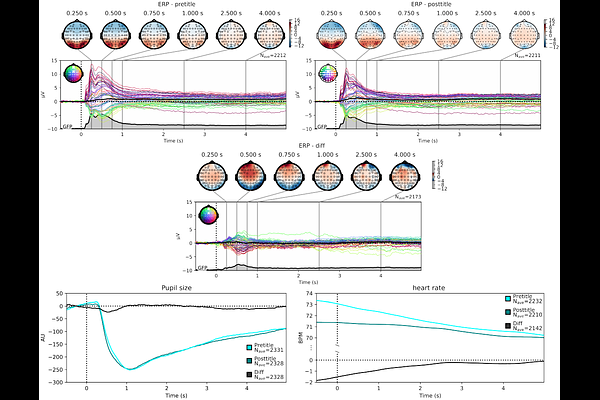Decoding the epistemic arc: Distinct physiological signatures for curiosity, insight, understanding and liking during interactions with visual art

Decoding the epistemic arc: Distinct physiological signatures for curiosity, insight, understanding and liking during interactions with visual art
Welke, D.; Vessel, E. A.
AbstractRecent work on insight and information processing suggested feelings of aha as a metacognitive feedback signal. A series of processes, from curiosity (drive state) to insight (uncertainty reduction) to pleasure (reward and reinforcement), might represent a fundamental epistemic arc for motivated learning. Here, we present a paradigm that combines measurement of curiosity, insight (aha), understanding and liking to outline the contours of this epistemic arc and study their neuronal mechanisms. In two preregistered experiments we employ the so called \"title effect\" - the fact that additional semantic information accompanying an artwork (such as titles) can change how an observer understands and enjoys a piece of visual art. Participants viewed paintings (5s trials) and rated their curiosity for seeing the title. This was followed either by the original title or a dummy title lacking additional information (\"untitled\"), and a second presentation of the painting, after which participants rated strength of aha, aesthetic liking, and feeling of understanding the artwork. In a behavioral online study (N=55 participants) we replicate a set of previous findings and established that visual art together with their titles can prompt strong feelings of aha. The association between the collected ratings is complex, partly nonlinear, and shaped by the type and amount of information provided by the stimulus material. In an EEG, ECG and eye tracking study with the same paradigm (N=49 participants) we aimed to characterize the temporal sequence of processing. Using a time-resolved decoding approach we were able to recover the categorical experimental conditions and the graded ratings: curiosity for the title could be decoded late in pretitle trials and early in the posttitle trials; aha could be decoded in posttitle trials; felt understanding had the most robust signature among the ratings and could be decoded from multiple signals in both pre and posttitle trials. Lastly, ratings of aesthetic liking were hard to decode from the data with only a short significant timewindow early during posttitle trials.